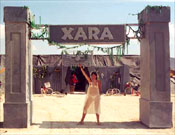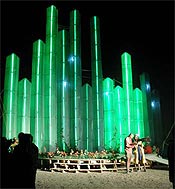Making our city a wonderful place to live is a complex and involved process. The city planning committee oversees changes to the city design. The theme camp team communicates with villages and theme camps and finds them their home. The placement team locates everyone as they enter our city. In 2002, we plan to add a map committee that will produce all maps for our city layout.
 Maps and Design
Maps and Design
Like any large architectural endeavor, creating the maps for Burning Man involves many overlays. Each focuses on a different aspect of the city. In January of 2001 the planning committee began with one simple plan based on the year before. From this we began reviewing the successes and weaknesses of the previous year. We added more living space for camps located in the Center Camp. We took out part of a road in the middle of the city to create living space for larger groups. We also added a grid system to assist the layout of theme camps and ease the process of going from planning to real playa placement. Every other placement concern fell into a timeline based on need and inspiration after this initial meeting.
Porta-potties and districts were defined next. Loud and quiet areas, family and late night party camps needed to be properly distanced. Traffic routes for service providers affect road widths and the placement of internal services and theme camps. Ingress and egress patterns, prevailing winds, non-Burning Man vehicular use on the Black Rock desert and the rising and setting of the sun were all considered before we began placing villages and theme camps.
Well over two-hundred hours of work between two people were spent strategizing with and on placement of registered camps alone. Upon completion of these placements, a second layer of plans were produced. These were the plans that we passed onto the DPW crews who place the survey flags that define boundaries for theme camps and villages on the playa surface. Only then did we begin to produce the detailed plans needed for various other crews and our sign shop. Plans for buildings, land/sea containers, shade structures, and power grid placement were drawn up with only weeks to spare before our event began.
Finally, a map for our participants was completed and sent to press on August 10, in time to meet the deadline for print production with the Black Rock Gazette (link to page F4) and the What Where When, the materials we give to participants as they enter our city. We were then two weeks away from our departure date for the desert.
Theme Camps and Villages
Theme camp mapping can be seen as a practical application of cultural geography. The goal is to create neighborhoods in which projects either complement each other, or create diversity. Many things are considered when mapping theme camps, including past project history, the present project proposal, size, particular placement requests, interactivity, and bets on whether the project will actually be completed. These factors help determine our geography. Our city is intentionally changed from year to year. Streets receive new names and some locations are reshuffled in order to discourage feelings of ownership and unmindful familiarities such as we are accustomed to at home.
 In 2001, Black Rock City housed 466 theme camps, including 16 villages. A total of 70 camps were placed on the Esplanade, 38 in Center Camp, and 29 in Large-Scale Sound-Art (2:00 and 10:00). The other 329 camps were located in non-Esplanade spaces. Approximately 1/4 of the Large-Scale Sound-Art camps were no-shows or relocated without telling us.
In 2001, Black Rock City housed 466 theme camps, including 16 villages. A total of 70 camps were placed on the Esplanade, 38 in Center Camp, and 29 in Large-Scale Sound-Art (2:00 and 10:00). The other 329 camps were located in non-Esplanade spaces. Approximately 1/4 of the Large-Scale Sound-Art camps were no-shows or relocated without telling us.
The importance of our online Theme Camp Questionnaire cannot be overemphasized. Along with our theme camp database, this is our primary tool. We began work to improve our database, produce new content for the website, and finish the mapping program (BRC Map) in January. The theme camp/village questionnaire was made available in February. By March we were well into conversations with camps about placement and special needs. The Large Scale Sound Art areas were full by March 15. In mid-June the theme art theme camps (camps designated to stamp passports for the 2001’s theme) were selected. After all of the information from each camp was compiled, we shut down access to the questionnaire, took our phones off the hook and “power mapping”, as we like to call it, began. By August 1 the city was laid out.
At this time the Theme Camp Placement crew kicked into gear. The city was divided into sections and each of these was assigned to a Placer. Placers made contact with the camps in their area of city before the event to answer questions and get people excited. Any last minute changes or updates were sent out on our announcement list.
 The Earth Guardians and other groups sent out special tips on this list as well. The last email announcement gave specific instructions on how theme camps would find their home. Once on the playa, the Placers worked hand in hand with the Greeters to make contact with each registered camp. They had a dedicated radio channel and worked as much as 16 hours a day until Wednesday when all camps had arrived The Placers continued to help solve problems for their camps and were always available as a resource.
The Earth Guardians and other groups sent out special tips on this list as well. The last email announcement gave specific instructions on how theme camps would find their home. Once on the playa, the Placers worked hand in hand with the Greeters to make contact with each registered camp. They had a dedicated radio channel and worked as much as 16 hours a day until Wednesday when all camps had arrived The Placers continued to help solve problems for their camps and were always available as a resource.
Some members of this team were also assigned to other tasks. These included assisting incoming traffic so that no one section of the city would became too packed, looking for unsafe structures, and making sure that Playa Information had the most updated information on which camps were placed. Everything is fluid on the playa, even after an entire year of planning.
Future
In 2002 this team will grow to include a person in charge of the plazas to make sure they become the social centers they deserve to be, with lanterns and spires, a fire pit, and a sense of community. We also look forward to more involvement with camps that wish to participate in next year’s art theme. These camps will have a dedicated contact person on the Placement team.
We will increase the efficiency of map production and attempt to streamline the placement process so that Placers are not left holding spots for camps that have no intention of camping where they are placed, but fail to contact us to let us know (this is a very time consuming and unpleasant task). We also intend to look for ways to further develop our use of the space dedicated to large-scale sound art.
As always, the planning committee will begin by looking at our city plan in January in order to make improvements for Black Rock City 2002.

